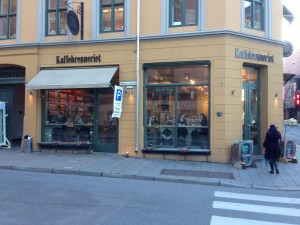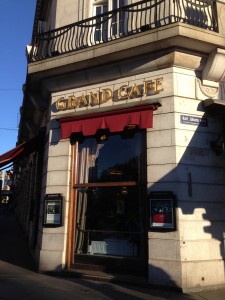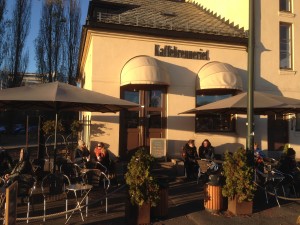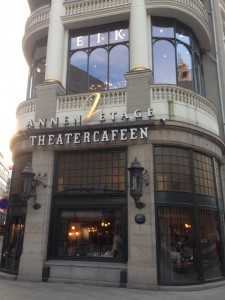Oslo’s cafe scene is well covered in Café Society, which I co-edited recently with Aksel Tjora, so I will not trespass on ground covered elsewhere. Instead, this is a personal piece, garnered from a working trip to see Dag Album and colleagues in November of 2013.
Annette and I sampled several cafes, from the luxurious Grand Café and Theatercafeen to more workaday places under the Kaffebrenneriat brand. I can read and even write pretty much anywhere if others are willing to tolerate and ignore me; but this is not to say that all cafes are equally conducive to concentration and productivity. The Grand Café and Theatercafeen are alike in their commitment to the luxurious interlude. What this means in practical terms is white starched tablecloths, busy cutlery and in mid-morning or afternoon dainty patisserie. It is an atmosphere and general messiness that discourages bookish pursuits. Fingers get sticky. Oldish money and ageing and smartly turned-out women are well represented in such places. I never shook off a sense that I was a tourist, albeit one with the curiosity of a sociologist.
 We had visited a reconstruction of playwright Henrik Ibsen’s appartment near the palace. After a period of self-exile abroad – he had become disenchanted at his lack of recognition at home – he returned and settled here from 1895 until his death in 1906. By all accounts he was a crusty and awkward eccentric with a frustrated and insatiable ego who coveted but was never awarded the Nobel Prize: like many men before and since he took out his irritation on the women in his life. Anyway, we were able to locate and gaze upon his corner table in the Grand Café, his home-from-home and one he apparently defended vehemently, showing a haughty disdain for any would-be interlopers. His bust, incidentally, stands alongside Bjornstjerne Bjornson’s at the front of the Nationaltheatret (where in 1899 Ibsen’s An Enemy of the People was the first play to be performed while the theatre was still in private hands).
We had visited a reconstruction of playwright Henrik Ibsen’s appartment near the palace. After a period of self-exile abroad – he had become disenchanted at his lack of recognition at home – he returned and settled here from 1895 until his death in 1906. By all accounts he was a crusty and awkward eccentric with a frustrated and insatiable ego who coveted but was never awarded the Nobel Prize: like many men before and since he took out his irritation on the women in his life. Anyway, we were able to locate and gaze upon his corner table in the Grand Café, his home-from-home and one he apparently defended vehemently, showing a haughty disdain for any would-be interlopers. His bust, incidentally, stands alongside Bjornstjerne Bjornson’s at the front of the Nationaltheatret (where in 1899 Ibsen’s An Enemy of the People was the first play to be performed while the theatre was still in private hands).
Cafes like Café Central and Theatercafeen are of sociological interest but, for me at least, less than ideal for ‘doing sociology’. Two cafes in the Kaffebrennariat ‘chain’ (is that the word?) met our bookish requirements. One was close to our hotel. My jottings after one of several visits record two American academics discussing US foreign policy at an adjacent table, students with scrawled notes, folders and Apple laptops catching up with lectures and preparing essays, and older clients perusing the daily papers; a very middle-class, gentle hubbub. I also recall a cramping of tables and chairs.
The other Kaffebrennariat café was on the waterfront. We came across it too late to make it a base but it became a late refuge for reading novels and chilling in temperatures hovering around freezing. Photos of all four cafes mentioned in this quick post are included.
The general lesson from Oslo? Maybe my working spaces are more circumscribed than I had thought. Given a choice I would opt for austere surroundings colonized by the proletariat rather than the bourgeoisie – oh, and plenty of noise and coming and going. But then there’s no guaranteeing of productivity whatever the setting.



